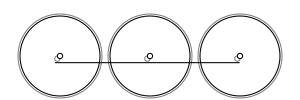0-6-0T
 |
|||||||||||||||||||

Hackworth's Royal George of 1827
|
|||||||||||||||||||
|
|||||||||||||||||||
|
|||||||||||||||||||
|
|||||||||||||||||||
| Equivalent classifications | |
|---|---|
| UIC class | C |
| French class | 030 |
| Turkish class | 33 |
| Swiss class | 3/3 |
| Russian class | 0-3-0 |
| First known tank engine version | |
|---|---|
| First use | 1850s |
| First known tender engine version | |
|---|---|
| First use | 1827 |
| Country | United Kingdom |
| Locomotive | Hackworth's Royal George |
| Railway | |
| Designer | Timothy Hackworth |
| Builder | Timothy Hackworth |
| Benefits | Total engine mass as adhesive weight |
| Drawbacks | Instability at speed |
Under the Whyte notation for the classification of steam locomotives, 0-6-0 represents the wheel arrangement of no leading wheels, six powered and coupled driving wheels on three axles and no trailing wheels. This was the most common wheel arrangement used on both tender and tank locomotives in versions with both inside and outside cylinders.
In the United Kingdom, the Whyte notation of wheel arrangement was also often used for the classification of electric and diesel-electric locomotives with side-rod coupled driving wheels. Under the UIC classification, popular in Europe, this wheel arrangement is written as C if the wheels are coupled with rods or gears, or Co if they are independently driven, the latter usually being electric and diesel-electric locomotives.
The 0-6-0 configuration was the most widely used wheel arrangement for both tender and tank steam locomotives. The type was also widely used for diesel switchers (shunters). Because they lack leading and trailing wheels, locomotives of this type have all their weight pressing down on their driving wheels and consequently have a high tractive effort and factor of adhesion, making them comparatively strong engines for their size, weight and fuel consumption. On the other hand, the lack of unpowered leading wheels have the result that 0-6-0 locomotives are less stable at speed. They are therefore mostly used on trains where high speed is unnecessary.
Since 0-6-0 tender engines can pull fairly heavy trains, albeit slowly, the type was commonly used to pull short and medium distance freight trains such as pickup goods trains along both main and branch lines. The tank engine versions were widely used as switching (shunting) locomotives since the smaller 0-4-0 types were not large enough to be versatile in this job. 0-8-0 and larger switching locomotives, on the other hand, were too big to be economical or even usable on lightly built railways such as dockyards and goods yards, precisely the sorts of places where switching locomotives were most needed.
...
Wikipedia
